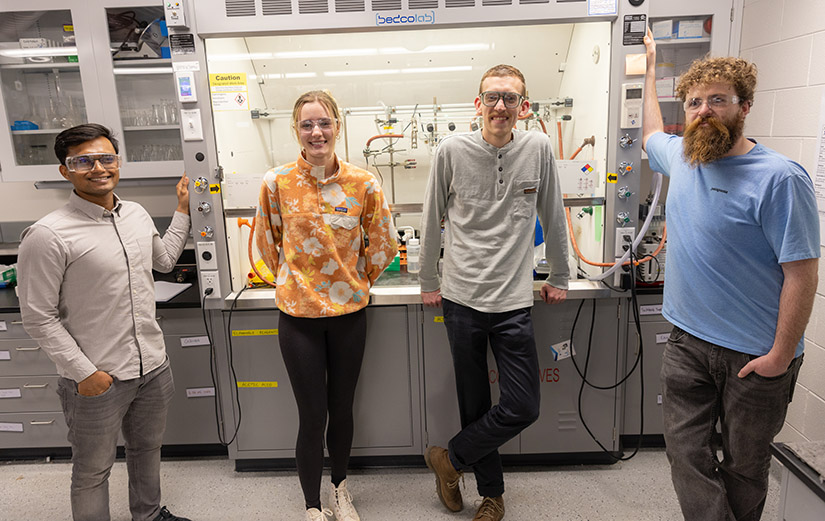NREL Publishes Method for Recycling All Components in Carbon Fiber Composites
Technology Helps Overcome Affordability Barriers to Wider Use and Manufacturing of a High-Value Material Found in Aircraft, Bicycles, Cars, and More

Deconstructing epoxy resins with hot acetic acid has the potential to provide a scalable and affordable solution for recycling a material used in a range of high-value consumer products, according to new research from the Bio-Optimized Technologies to keep Thermoplastics out of Landfills and the Environment (BOTTLE) consortium.
Carbon fiber composites (CFCs) are high-strength, low-weight materials made from epoxy-amine resins that encase long carbon fibers. CFCs enable lighter and more efficient bicycles, planes, and automobiles and are a critical component of the pressure vessels used for compressed natural gas shipping and storage. However, the cost and energy-intensive production of CFCs limits their application, and there is a near total lack of scalable and economically viable recycling methods for these important materials.
CFCs are generally made with epoxy-amine resins, similar in chemistry to many epoxies commonly found in hardware stores. These composites form a stiff and resistant plastic, but also one that cannot be dissolved or melted. While the resins are relatively cheap, the fibers they surround are not, so the resulting composites are quite expensive—many CFCs can cost well over $50 per pound.
“For a reasonable analogy, imagine a cake,” said Stephen Dempsey, a postdoctoral researcher at the National Renewable Energy Laboratory (NREL) and one of the first authors of the study. “Once the egg, flour, and sugar are in the batter and that cake is baked, it’s basically impossible to get them back out. It is similar here: The resin is chemically interlocked, and the bonds are quite strong. We have to do something intense to get the fibers out, but we also must be careful not to degrade the chemicals in the resin beyond what’s necessary, as that would waste all the time, energy, and raw materials that went into making them in the first place.”
But even then, there is a bit more complexity than in baking, because these resins are often made of highly complex mixtures of molecules. Some of these compounds are common, and shared across many industries that use CFCs, but others are not. In addition, it is currently challenging to identify exactly what the resin chemistry is before recycling. A recycling method for CFCs must therefore be extremely robust and capable of handling diverse resin formulations.
The BOTTLE team’s solution ended up being surprisingly simple. Hot acetic acid, the same compound that is found in vinegar, can cleave all the key bonds within these resins. Former NREL postdoctoral researcher Ciaran Lahive (now at University of Manchester), and co-first author on this study, demonstrated this reaction during an intensive reaction screening effort for another project.
The team learned something remarkable: Not only do the polymer networks in the resin solubilize rapidly, but the acetic acid also stabilizes their chemical components, enabling high yields of reusable chemical building blocks. Extensive optimization work from NREL interns Katie Stevenson (now at Columbia University) and Sydney Reiber (now at the University of Graz) led to a process effective on end-of-life waste from a variety of industries.
Importantly, the researchers also determined there was no impact on the strength of the recycled carbon fibers (rCF), which is critical to ensuring they retain their value after being extracted from the composite. To demonstrate this, they took 80 grams of a scrap mountain-bike frame made of composite material and deconstructed it. Using the carbon fibers they had just extracted, they then made new composites that exhibited more than twice the strength-to-weight ratio of steel.
Not only is the cost of rCF predicted to be quite low compared to virgin fiber, with a price of just $1.50 per kilogram, but the energy consumption is also practically zero when factoring in the recovered epoxy building blocks. The process is not limited to CFC only—glass fiber composites like those found in turbine blades, boat hulls, or automobile bumpers and hoods could also be treated.
“Long-term, this technology could be used to create value from challenging composite waste streams that are currently piling up in landfills,” said BOTTLE CEO Gregg Beckham, the senior author of the study and a senior research fellow at NREL. “Current technologies are not yet able to make a dent in that waste stream, but we think that this process could be useful for this application as well.”
The discovery holds the potential to energize the U.S. composite manufacturing industry.
“If we can scale this process and deploy it in the real world, we see no reason that whole panels on cars or trains couldn’t be made of rCF composites instead of steel or aluminum,” Dempsey said.
The paper, “Acetolysis of epoxy-amine resins for carbon fiber-reinforced polymer recycling,” appears in the journal Nature. The other coauthors from NREL are William Michener, Hannah Alt, Kelsey Ramirez, Erik Rognerud, Clarissa Lincoln, Ryan Clarke, Nicholas Rorrer, and Katrina Knauer.
Funded by the U.S. Department of Energy’s Advanced Materials and Manufacturing Technologies Office and Bioenergy Technologies Office, the work was performed as part of the BOTTLE consortium. Additional funding was provided as part of a BOTTLE funding opportunity announcement with the University of Delaware’s Center for Composite Materials.
Explore NREL bioenergy and bioeconomy research, including recyclable-by-design materials research.
Last Updated May 28, 2025
